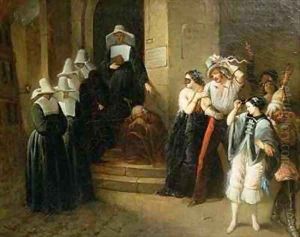Henri Victor Deveria Paintings
Henri Victor Deveria was a French painter, lithographer, and photographer, primarily known for his lithographic portraits of famous personalities of his time. He was born on February 20, 1808, in Paris, France. Deveria was part of the Romantic art movement that swept through Europe in the 19th century. His works, however, did not achieve the same level of fame as some of his contemporaries, such as Eugène Delacroix or Théodore Géricault.
Deveria began his artistic career under the tutelage of his brother, Achille Deveria, who was an established painter and lithographer himself. Henri Deveria's works included a variety of subjects, from portraits to historical and mythological scenes. He gained recognition for his portrait lithographs, which captured the likenesses of prominent figures of his time, including writers, politicians, and royalty.
In the 1830s, Deveria's interest in new technologies led him to embrace photography, which at the time was a burgeoning art form. He became one of the early French photographers, experimenting with the medium and contributing to its development. Photography allowed Deveria to capture images with a level of detail and realism that was difficult to achieve with lithography.
Deveria's involvement with photography also coincided with his work at the Bibliothèque Royale (now the Bibliothèque Nationale de France), where he served as a curator. His role there gave him access to a wide range of artistic and literary material, which he used to inform his own work.
Despite his contributions to lithography and photography, Deveria's name is not as widely recognized as some of his peers. He passed away on December 12, 1855, in Paris. Today, Henri Victor Deveria's works can be found in various museum collections, and he is remembered for his participation in the early days of photography and for his lithographic portraits that captured the spirit of 19th-century France.

